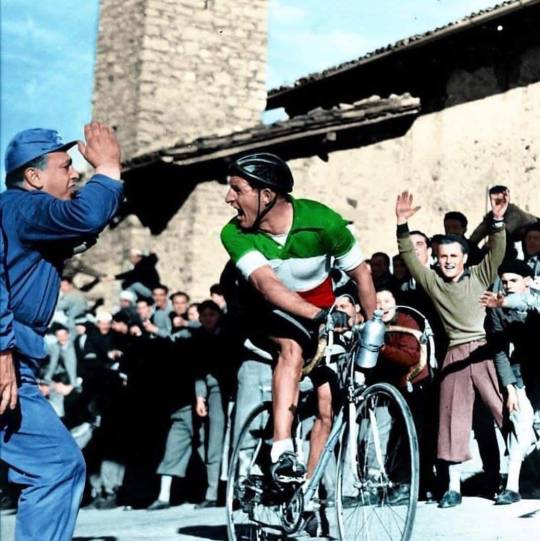#gino bartali
Photo
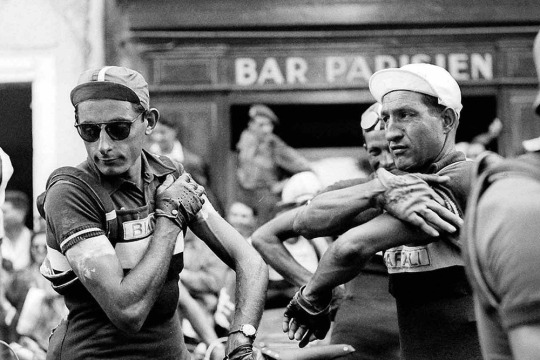
Fausto Coppi & Gino Bartali.
#sport#cycling#fausto coppi#gino bartali#legends#fashion#men#icons#iconic#vintage#classic men#elegant
282 notes
·
View notes
Text
Le "vieux" Gino Bartali dans le col d'Izoard (Tour 1948). https://t.co/W37fYj1xl2

71 notes
·
View notes
Text
Cycling history using memes
Giro de Italia 1952:

Raphael Géminiani: "I entered Fausto Coppi's Bianchi through the front door in 1952, a rare privilege. There was this great rivalry with Gino Bartali which was not feigned. If Coppi was very popular in France, the hero, the icon in Italy, was Bartali. That year, he was Italian champion, so, to annoy him, so that people wouldn't recognize him, Fausto forced our teammate Donato Piazza to wear his tricolor pursuit champion jersey and told him "Ride in the lead"! It was prohibited by the rules. But, seeing this green-white-red jersey, the public shouted “Bartali, Bartali!” Behind, Gino passed into anonymity. Every day, Fausto paid the fine."
Fyi: This got confusing for a hot second, because I also found an article mentioning this very same happenstance but with Antonio Bevilacqua being forced to wear his pursuit jersey.
Cue me having to try and find out who of the two it was, despite being sure that Gem is not remembering it wrong.
(I found Gem's quote on an article about how he helped Coppi win the 1952 Giro, and Bevilacqua was neither pursuit Champion that year, nor did he ride the Giro)
#talking about petty bitches#fausto coppi#gino bartali#raphael geminiani#donato piazza#giro de italia 1952#cycling history lessons#cycling history#cycling#cycling stuff#antonio bevilacqua#poor fella confusing the fuck out of me
2 notes
·
View notes
Text
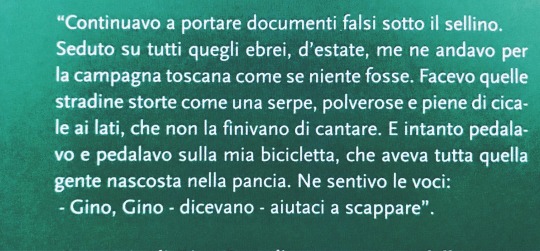




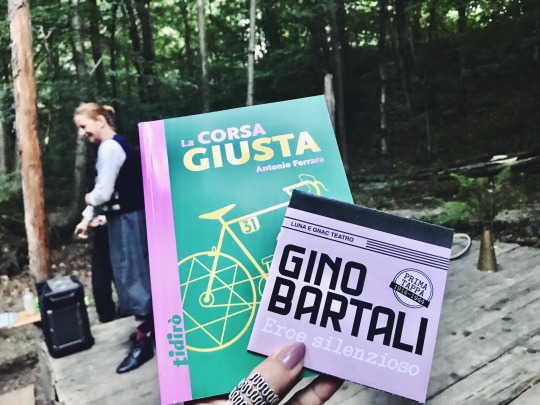
A commuoversi per una storia bellissima, davanti ad un palco in un bosco.
Questo posto continua a fare regali inaspettati.
© reserved - Please don’t remove captions or photos - Thanks
10 notes
·
View notes
Text
Gino Bartali e il Tour de France del 1948: una vittoria che salvò l'italia
La più grande impresa sportiva della storia italiana, la vittoria di Gino Bartali al Tour de France 1948. Tra colline toscane e sfide alpine, la leggendaria impresa ha cambiato il destino dell’Italia.
In questo articolo, esploreremo in dettaglio l’epopea di Gino Bartali attraverso le parole che raccontano di tenacia, passione e audacia. Dal cuore delle colline toscane, dove la sua storia ha…

View On WordPress
#Ciclismo Italiano#Ciclista Straordinario#Colline Toscane#Epopea Ciclistica#Gara Iconica#Gino Bartali#Imprese Sportive#Italia post II guerra mondiale#Leggenda Sportiva#Orgoglio Nazionale#Passione Ciclistica#Racconto Sportivo#Sfide Alpine#Sfide Epiche#Storia Del Ciclismo#Storia Italiana#Supercampione#Tour de France#Tour de France 1948#Vittoria Trionfante
0 notes
Text
ALESSANDRIA. L'ARCO SI TINGE DI GIALLO PER 111^ EDIZIONE DEL TOUR DE FRANCE.
TOUR DE FRANCE
A 100 giorni dalla partenza, Alessandria si tinge di Giallo
Quest’anno il Tour de France, giunto alla sua 111° edizione, percorrerà per la prima volta le strade italiane e omaggerà grandi campioni del passato, da Fausto Coppi a Gino Bartali e Marco Pantani, che hanno contribuito a rendere grande il ciclismo e hanno cementato la grande passione italiana per la bicicletta.
Il 1°…
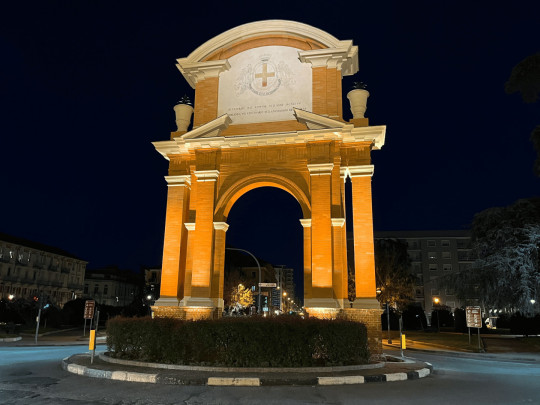
View On WordPress
0 notes
Link
real life superhero!
42K Likes, 686 Comments - Bicycle Film Festival (@bicyclefilmfestival) on Instagram: "@jewishfactsdaily “Good is something you do, not something you talk about.” - Gino Bartali C..."
#@jewishfactsdaily “Good is something you do#not something you talk about.” - Gino Bartali Cycling legend#Gino Bartali used the bicycle to save Jewish lives.#Bicycle Film Festival on Instagram:#real life superhero!
0 notes
Text
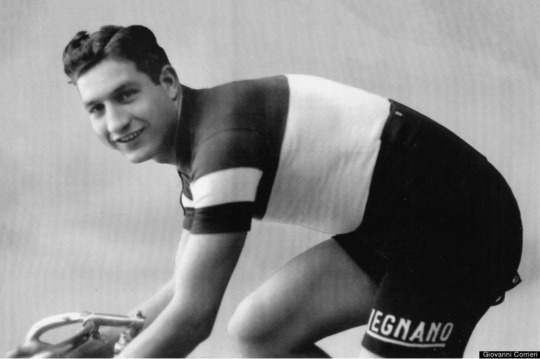
THURSDAY HERO: Gino Bartali
Born in a small town near Florence in 1914, Gino grew up extremely poor. He escaped his difficult life by riding his bike from dusk until dawn around the hills of Tuscany. Building up exceptional strength and endurance, Gino started competing and winning races. Only a few years after his first race, he went professional. By the early 1930’s, Gino was a household name throughout Italy. Everywhere he went he was mobbed by fans. When he won the Tour de France in 1938, at age 24, Gino was hailed as the “King of Cycling.”
Gino wasn’t able to defend his title at the 1939 Tour because of worsening relations between Italy and France. He was drafted into the army and worked as a military bike messenger. In 1943, Germany invaded Italy and immediately began rounding up and deporting Italian Jews. A friend of Gino’s asked him to help save their Jewish brethren. Though married and with a young son, Gino did not hesitate. He immediately committed to doing whatever he could to save lives, whatever the risk.
Gino sheltered a local Jewish family in an apartment he bought with cycling money. He then embarked on a dangerous mission smuggling fake identity papers around Tuscany and Umbria, enabling Jews to assume false identities and escape deportation. Using his training routes between Florence and Assisi, Gino made 30-40 trips, saving at least 800 Italian Jews. He carried exit visas in his bicycle frame. Wherever he went, Gino was surrounded by fans, preventing German policemen from looking too closely at what he was doing. On the few occasions he was stopped and searched, Gino insisted that his specially-made bike was too delicate to be touched. A devout Catholic, Gino often traveled from Florence to Assisi and back in one day – a 200 km trip. In Assisi, Catholic clergy ran an underground railroad to hide Jews and provided them with Gino’s fake identity documents.
Gino was extremely modest and rarely spoke about his wartime heroism. He once told his son, “If you’re good at a sport, they attach the medals to your shirts and then they shine in a museum. That which is earned by doing good deeds is attached to the soul and shines elsewhere.” It wasn’t until after his death in 2000 that his family began speaking publicly about what Gino had done. In 2013, Gino was honored by Israeli Holocaust Museum Yad Vashem as “Righteous Among the Nations.”
For using his talent and fame to save hundreds of lives, we honor Gino Bartali as this week’s Thursday Hero at Accidental Talmudist.
54 notes
·
View notes
Text

Italian Legend
The story of the Campagnolo Gran Sport begins immediately after the Second World War. It was a time when cycle racing was dominated by two Italians - Gino Bartali and Fausto Coppi.
Gino Bartali, a conservative man who saw himself as a skilled craftsman, loved the intricasies and complexities of Tullio Campagnolo's Heath Robinson rod-operated gear changers like the infamous Campagnolo Corsa. He used one to win the 1948 Tour de France.
Fausto Coppi, however, revelled in modernity, progress and technology - and despised Tullio's ornate contraptions. In 1949 Fausto Coppi defected from Campagnolo to Simplex, and horror of horrors, won the Tour de France. An Italian demi-god had triumphed using French equipment. Tullio Campagnolo was humiliated and mortified.
But the shock was exactly what was needed to get the, ever-cautious, Tullio off his backside and spur him to produce, in 1951, his signature Campagnolo Gran Sport derailleur. It, famously, adopted a parallelogram mechanism, and its strength and accuracy defined the way that derailleurs operate up to this very day
Quotation, at length, from Disraeli Gears
#ciclismo#cycling#velo#bike#road cycling#bicycle#bicycling#Campagnolo#Cycling History#Bike Components#Campagnolo Gran Sport#b&w photography#black and white
16 notes
·
View notes
Text
Bartali. La scelta silenziosa di un campione
L’impresa più grande di Gino Bartali non fu una vittoria sportiva, ma una silenziosa scelta di umanità: l’adesione alla rete clandestina Delasem e la sua attività di corriere che, negli anni durissimi della Seconda guerra mondiale, aiutò tanti ebrei in Italia a sfuggire alla persecuzione nazifascista. Questa biografia a fumetti fa rivivere le tappe, i trionfi, il mito del campione di ciclismo,…
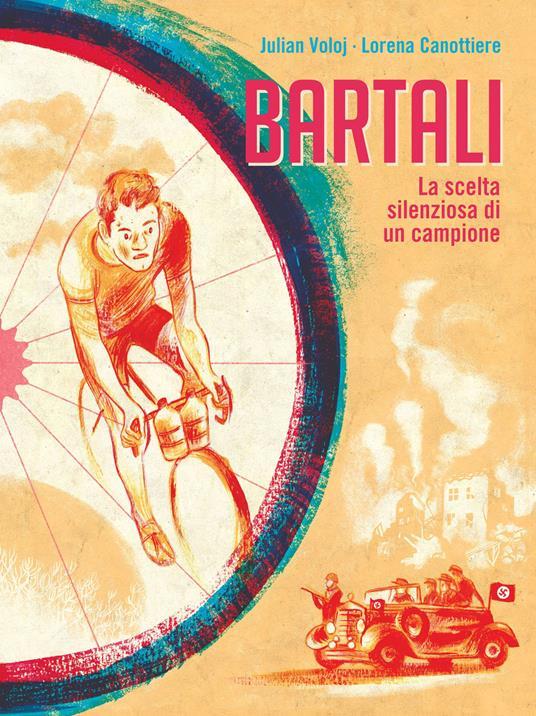
View On WordPress
2 notes
·
View notes
Text
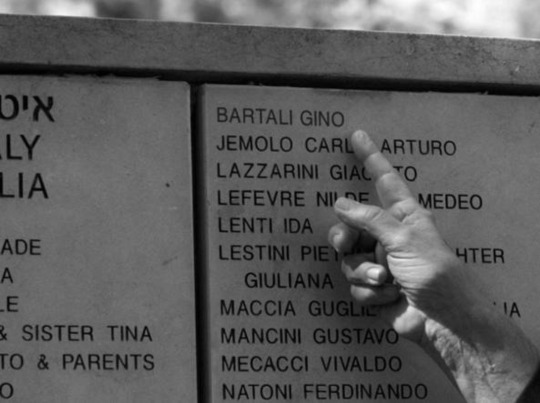
Il BENE SI FA E NON SI DICE E CERTE MEDAGLIE SI APPENDONO ALL'ANIMA E NON AL BAVERO DELLA GIACCA...
.
.
.
GINO BARTALI
5 notes
·
View notes
Text
Tour de France Zodiac

Cancer (22nd June - 22nd July)
Louis Trousselier
Odile Defraye
Gino Bartali
Federico Bahamontes
Greg LeMond
Miguel Indurain
#tour de france zodiac#cycling cancer#louis trousselier#odile defraye#gino bartali#federico bahamontes#greg lemond#miguel indurain#classic tdf#classic tour de france
2 notes
·
View notes
Text
LO STATO DELLA COSE_CHIARA ALESSI
Ci sono e ci sono state pochissime persone, e pochissimi intellettuali, che hanno raccontato la Storia (quella con la “S” maiuscola) attraverso la storia degli oggetti. Così a memoria mi vengono in mente Paolo Fossati, Bruno Munari, ma anche Neil MacGregor, ricordando quel gran libro che è “La storia del mondo in 100 oggetti”. Non posso poi non citare Andrea Branzi e Kenya Hara e la loro grandiosa mostra “100 verbi” di qualche anni fa alla Triennale di Milano. Indubbiamente qualcuno c’è stato, ma non sono molti. È anche per questo che ho accolto con interesse e curiosità “Lo Stato delle cose” (Longanesi) di Chiara Alessi, dopo aver già letto “Tante care cose” lo scorso anno. Chiara Alessi entra quindi di diritto nel novero dei “raccontatori” della Storia attraverso le cose. “Lo stato delle cose” non è tuttavia la prosecuzione del libro precedente, pur trattando anch’esso di oggetti, in quanto in questo volume non si tratta più di oggetti di design, ma di oggetti di uso comune, ma in un certo senso molto simbolici. Non per nulla il sottotitolo del libro è “Breve storia della Repubblica per oggetti”. Chiara Alessi sceglie di parlare di sei “oggetti”, la borraccia, la penna a sfera, la “schiscetta”, il passamontagna, la striscia rossa dei carabinieri, il fiore del logo Fininvest. Apparentemente questi oggetti reali e simbolici, non sembrano avere un diretto rapporto tra loro, ma Chiara Alessi, racconta una storia fatta di legami sottili, che l’autrice ricerca con passione e che effettivamente appaiono convincenti, ma soprattutto affascinanti. La borraccia (in realtà una bottiglia) che apre il volume è quella che si scambiano Coppi e Bartali al Tour de France. Un’immagine pubblicata su “Lo sport illustrato”, che colpì molto la fantasia popolare, ma che forse non era un’immagine così genuina come si potesse pensare. Chiara Alessi, partendo dalla ricostruzione di tutto ciò che sta intorno a quello scatto, ci racconta la storia di questo oggetto e del suo mutare, anche in relazione alla storia del costume e della storia tout court. Le stessa cosa avviene, nel capitolo successivo, (che ha in realtà moltissimi punti di incontro con il capitolo precedente) per la penna a sfera, a cominciare dal legame con Gino Bartali, primo testimonial di una penna (sebbene stilografica) nel 1953. Questa capacità della Alessi di tenere vivo il legame tra gli oggetti, prosegue per tutto il libro. E così dopo la penna a sfera, messa in cantiere dall’ingegnere torinese Marcel Bich, e la penna Aurora prodotta da Olivetti grazie a Marcello Nizzoli, è la volta della”schiscetta, il contenitore per il pasto della classe operaia, che vedrà ancora la Olivetti come esempio inimitabile ed inimitato, nel rapporto tra impresa e classe operaia. Insomma come si sarà capito, non si tratta solo di oggetti, ma di rapporti umani, sociali, economici e di politica in senso nobile. È in questa chiave che viene raccontata la storia del passamontagna, indumento che da pratico diventa simbolico (ricordiamo il passamontagna dei terroristi o quello delle Brigate Rosse), ma è anche la storia del Conte di Cardigan che utilizzò il passamontagna per le truppe inglesi in Crimea, quello del Subcomandante Marcos e quello delle Pussy Riot. Capita la stessa cosa anche per il curioso capitolo sulle strisce rosse dei pantaloni dei carabinieri, la striscia rossa più famosa d’Italia, che fanno parte di una “uniforme” e non di una “divisa”, cosa molto diversa anche da un punto di vista concettuale. Anche il fiore del logo Fininvest contiene allusioni, significati e relazioni che sono tutt’uno con la storia del nostro Paese (ah già, dimentico sempre che adesso si deve dire “nazione”). Insomma un libro che parlando di “cose” in realtà parla di tutto, perché sono le cose che spesso parlano di tutto, basta trovare solo chi, come Chiara Alessi, riesca a farle parlare…

2 notes
·
View notes
Photo

“Il bene si fa, ma non si dice.
E certe medaglie si
appendono all'anima,
non alla giacca.”
Gino Bartali
5 notes
·
View notes

